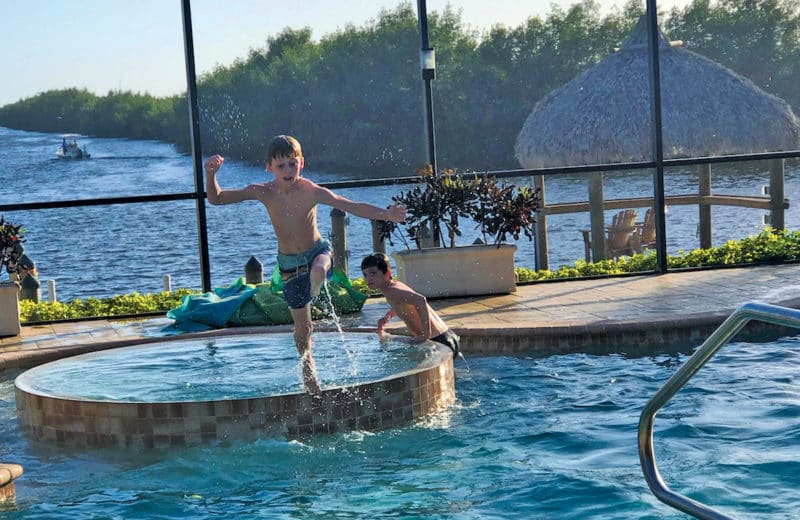By Nancy Maes
You might think you know the signs of drowning: a kid frantically waving his arms high in the air and screaming for help over and over again. But in reality, the signs of distress are much more subtle.
“People who are drowning very rarely call out for help. If they do, it’s just once because they’re using any air they have to keep themselves afloat,” says Theresa Donnelly, who trains lifeguards and water safety instructors for the American Red Cross of Greater Chicago. “They’re bobbing up and down and have no supporting kick. Unfortunately, sooner rather than later, they will slip under the water. It can happen very quickly, within seconds. It takes about five minutes for them to drown fatally.”
The statistics tell a tragic tale. Drowning is the second leading cause of death, after birth defects, for children between the ages of 1 and 4, according to the Centers for Disease Control and Prevention. Approximately 10 people in the United States die every day from unintentional drowning, and two of them are children aged 14 or younger. For every child who dies, another five nonfatal drowning victims are treated in emergency rooms for injuries that include serious brain damage.
Swim lessons can help. For many years, the American Academy of Pediatrics (AAP) advised against them for children under age 4. “The concern was that children [in that age group] weren’t yet ready to learn to swim, and if they took lessons, their parents would have the unrealistic expectation that the children would be able to save themselves if they fell into the water,” says Jeffrey Weiss, MD, a pediatrician at Phoenix Children’s Hospital.
But in 2010, that policy was updated, based on a study saying that formal swimming lessons reduced the risk of drowning. “It said that swimming lessons for kids aged 1 to 3 may help prevent drowning and that [having these lessons doesn’t] seem to be dangerous,” says Weiss, who was the lead author of the revised policy. “The evidence was not strong enough for us to recommend that every parent should run out and get their younger kid swimming lessons. The statement just says that if you want to, it’s not a bad thing.” The 2010 policy is currently being reviewed, but no further details are available, according to an AAP spokesperson.
Drowning prevention begins at home. Parents may think that a small child is safe in a baby pool because the water is so shallow, but that is definitely not the case. “You only need enough water to cover your nose and mouth to drown,” Donnelly says. Adults should always remain within an arm’s reach of young children in the water, and baby pools should always be emptied when not being used so that little ones can’t go into the water on their own.
Swimming pools need to be childproofed, too. “Four-sided pool fences with a self-closing, self-locking gate are an effective way to prevent drowning,” Weiss says.
While water wings and inflatable objects can keep kids afloat in the water, they do not prevent drowning. They allow children to go into water that is too deep for their swimming ability, and the blowup toys can deflate or flip around, causing children to become facedown. “They give a false sense of security,” Donnelly says. U.S. Coast Guard-approved life jackets are recommended for young children and inexperienced swimmers when they are around the water.
A day at the beach can be the ideal way to spend a summer day, but Lake Michigan presents its own treacherous hazards. While there may be delightful, shallow sandbars, there also can be steep, unseen drop-offs into deep water. Waves may have undertows below the surface that are strong enough to pull bathers away from the shore. Rip currents, like fast-moving, narrow rivers flowing away from the shore, can pull swimmers into deeper water. Swimmers caught in a rip current should swim parallel to the shore until they reach calmer water and then swim to safety. Adults should constantly supervise their children when they are in the water. “Lifeguards are not babysitters,” Donnelly says.
When someone is drowning, the advice is easy to remember: “Reach or throw, don’t go.” That is, reach out with something, like a branch or a pole, that the drowning person can grab onto, or throw the person an object that floats, such as a ring buoy or even an empty closed cooler.
“Anyone who is not a trained lifeguard should not try to save someone,” Donnelly advises. “I don’t want a parent who doesn’t know how to save someone jumping in any water that’s deeper than their chest to save their child, because a 3-year-old can take a grown man to the bottom. It’s difficult to swim holding someone else above the water.” Lifeguards are trained on how to free themselves from a struggling victim, she says, as well as trained to enter the water with a flotation device to prevent injury to the victim or the rescuer.
These recommendations only skim the surface of water safety tips, but these basics are crucial precautions to prevent children from drowning and will allow you to safely enjoy your time in the water.













